
Best Things To Do in Venice | The Ultimate Guide
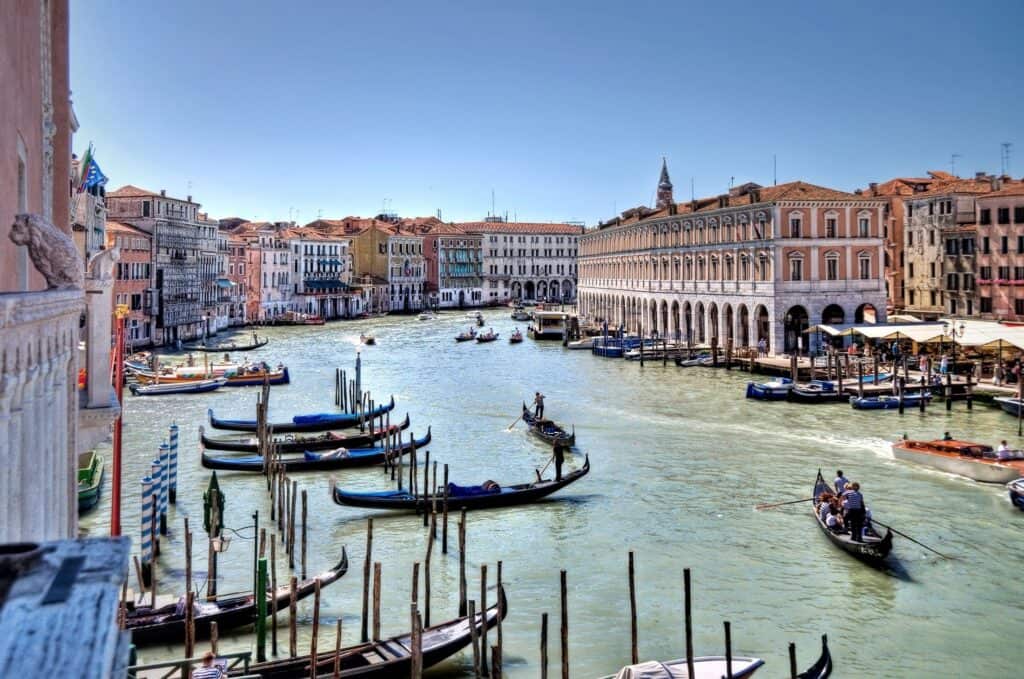
Venice has captivated visitors for centuries. Located in the Veneto region of northern Italy on the Adriatic Sea it was one of Europe’s most important trading ports during the Middle Ages and Renaissance eras.
Today, this enchanting city is known for its winding canals lined with gondolas and colourful palazzos creating a truly magical and unique experience. From breathtaking landmarks to unparalleled views, there are countless things to explore in Venice – making this one of the world’s most popular destinations for travellers from all corners of the globe.
The list of sites to visit is very long and in many cases, most visitors spend just a few days in the city. Therefore, we have created the ultimate guide covering all the key attraction and the best things to do; to allow you to pick and choose what interests you the most in the time that you have.
Our guide covers everything from the famous Grand Canal and the breathtaking buildings on St. Mark’s Square, to all the best churches, museums, cafes and key islands to visit in the Venice lagoon.
So let’s get started.
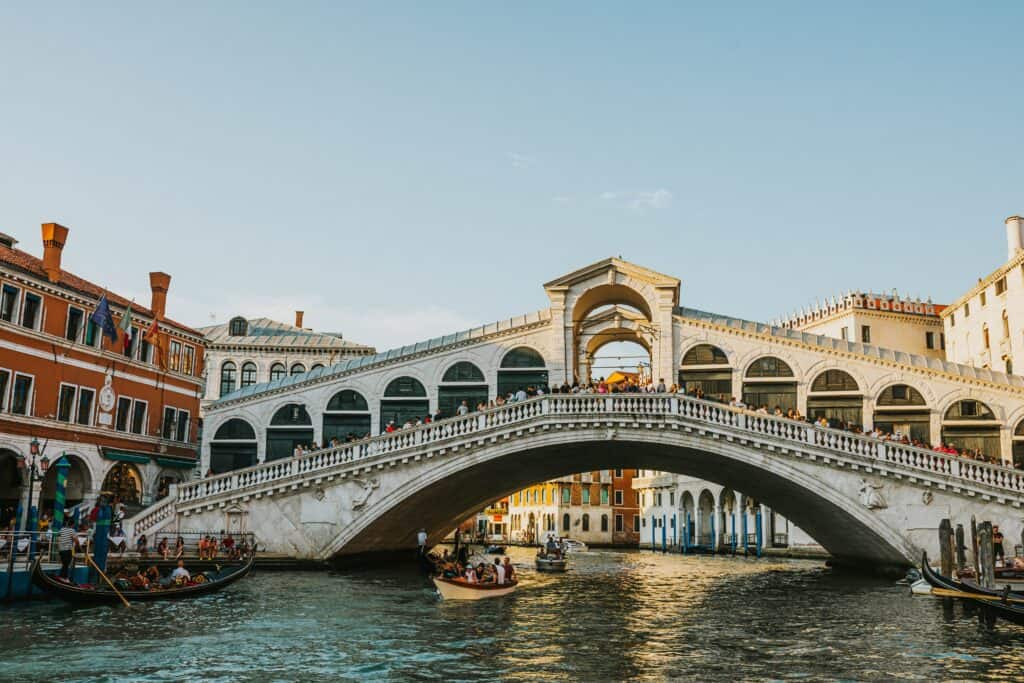
The Grand Canal & Bridges
The Grand Canal is one of the most important features of this city. This famous scenic waterway winds through the heart of the city in a graceful ‘S’ shape flowing past some of Venice’s most iconic landmarks.
Everyone must take a ride on this magical waterway and view the palaces and churches, old factories, and historic homes – all reflecting Venice’s incredible history.
Ways To Travel On The Grand Canal
The ways to travel on the Grand Canal are taking a gondola, a water taxi, the vaporetto (public ferry) or hiring a private motorboat.
The most inexpensive way to travel the length of the Grand Canal is by taking the vaporetto, Line 1. This is the big show line and the vaporetto traverses the entire length of the Grand Canal in both directions (and out further to the Lido area); approximately 20 stops in total.
Bridges Over The Grand Canal
4 bridges cross the Grand Canal and from these bridges you get some of the best views of the Grand Canal and the city.
Rialto Bridge (Ponte de Rialto)
The Rialto Bridge is one of the most famous landmarks in Venice and also the oldest bridge that spans this historic waterway. The bridge has undergone multiple reconstructions since the original construction in the 17th century and continues to be an iconic symbol of Venetian culture and architecture. A huge popular attraction, the Rialto Bridge offers stunning views of both the canal below and the city skyline. Its unique design features two inclined ramps that meet in the middle to form a gentle arch. Whether you’re looking for a romantic spot or want to take in some amazing sights, visiting the Rialto Bridge should be at top of your list when visiting Venice.
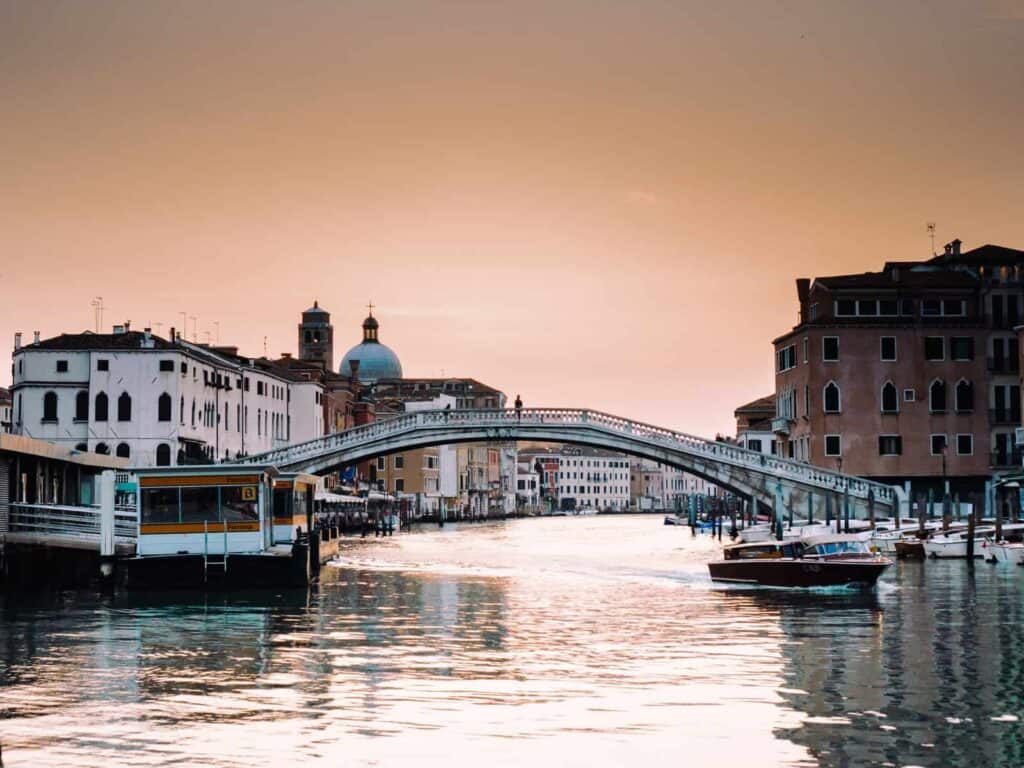
Scalzi Bridge (Ponte degli Scalzi or Ponte dei Scalzi)
This 20th century bridge crosses the Grand Canal at the northern end and connects the neighbourhoods of Santa Croce and Cannaregio. The Church of the Barefoot Monks (Chiesa degli Scalzi) is located on the north side of this bridge, which is from where the bridge gets its name from.
Accademia Bridge (Ponte dell’Accademia)
This bridge spans the Grand Canal (at the southern end) and connects the neighbourhoods of San Marco and Dorsoduro. This bridge offers some of the best views of the Grand Canal and is where you will find the Accademia museum located.
Constitution Bridge (Ponte della Costituzione)
The city’s newest bridge opened in September 2008 and was built to connect the train station with the parking and the port area.
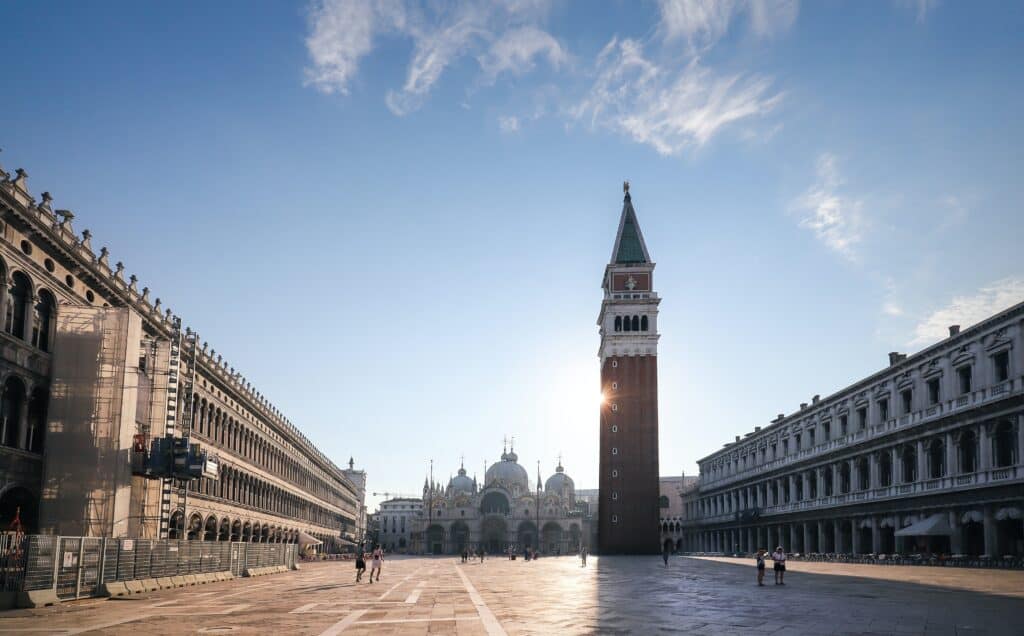
St. Mark’s Square (Piazza San Marco)
St. Mark’s Square is one of the most beautiful and iconic spaces in the world. Located in the heart of the city, it is surrounded by the most impressive buildings, including St. Mark’s Basilica, the Doge’s Palace and the Campanile di San Marco. The Square itself is the largest space in city and throughout the centuries has been the site of many important historical events such as coronations, processions and festivals.
The grand buildings on the three sides of the Square are today housed with cafes and museums. On the fourth side sits the magnificent St. Mark’s Basilica and the Doges Palace. The Square then opens out into the impressive Venice lagoon. Throughout the day, tourists, locals and pigeons all congregate in St. Mark’s Square to enjoy its grandeur and space.
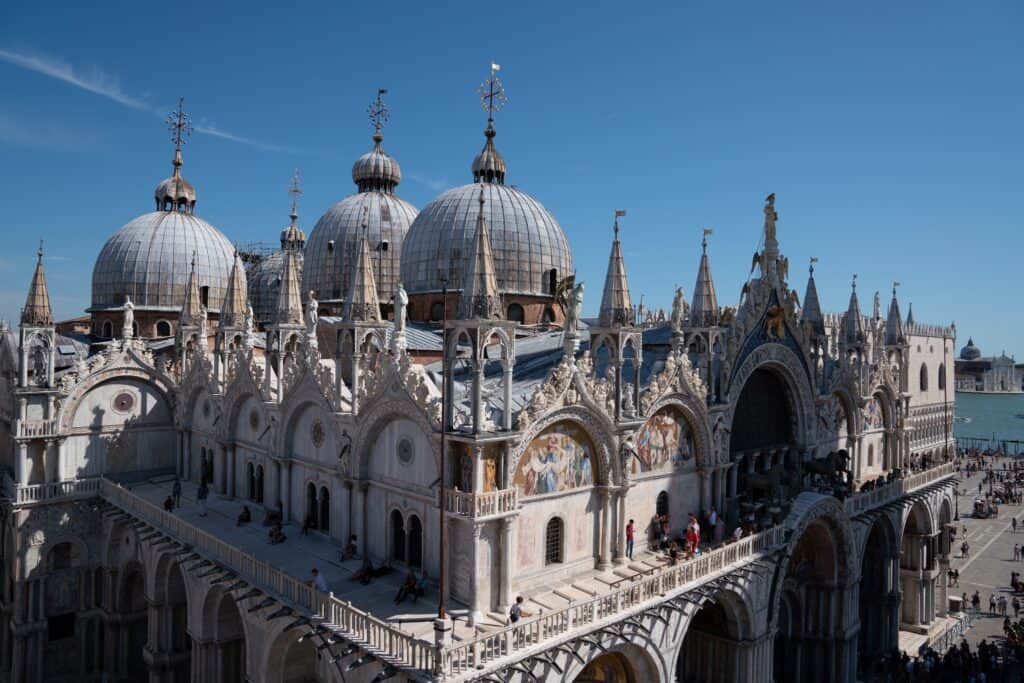
St. Mark’s Basilica (Basilica di San Marco)
Venice’s cathedral, St. Mark’s Basilica, is located on the eastern end of St. Mark’s Square. This building is the crown jewel of Venice and a visit to this grand cathedral should not be missed.
The site itself dates back to the 9th century when the original church stood and was built to house the bones of the apostle St. Mark. The relics of St. Mark came to Venice when a group of merchants stealthily smuggled the Saint’s remains out of Egypt.
Today the cathedral’s exterior is styled in both gothic and byzantine architecture, decorated in sculptures, columns and mosaics and topped with impressive domes. The mosaics depict stories from the bible as well as figures from classical mythology.
The inside is equally impressive, decorated with metres and metres of coloured and golden mosaics, statues, altars and chapels.
Why Visit St. Marks Basilica?
Firstly this building stands out amongst all other buildings in Venice due to its grandeur and scale; it truly is a sight to behold.
Secondly, it holds so many riches, many of which were take from Constantinople.
Inside the building, the cathedral space and treasury is full of so much art and artefacts made out of precious stones, gold and silver. Key attractions include the Pala d’Oro, a Byzantine alter piece covered in gold and gems and the magnificent four bronze horses from Constantinople. Replicas can also be seen outside on the terrace, where there originals stood when they came to Venice in the 12th century.
Tips for Visiting
The Basilica is open every day (9:30-5pm) and as is it so popular get there early. On Sundays and Holy days, the Basilica opens after 2pm. Last entry is normally 15 mins before closing.
Entrance into the basilica is free but visiting certain parts of the Basilica will require additional entry fees; such as the treasury.
Finally, remember that this is a place of worship, so dress appropriately and keep your voice low. Photography and filming are not allowed inside.
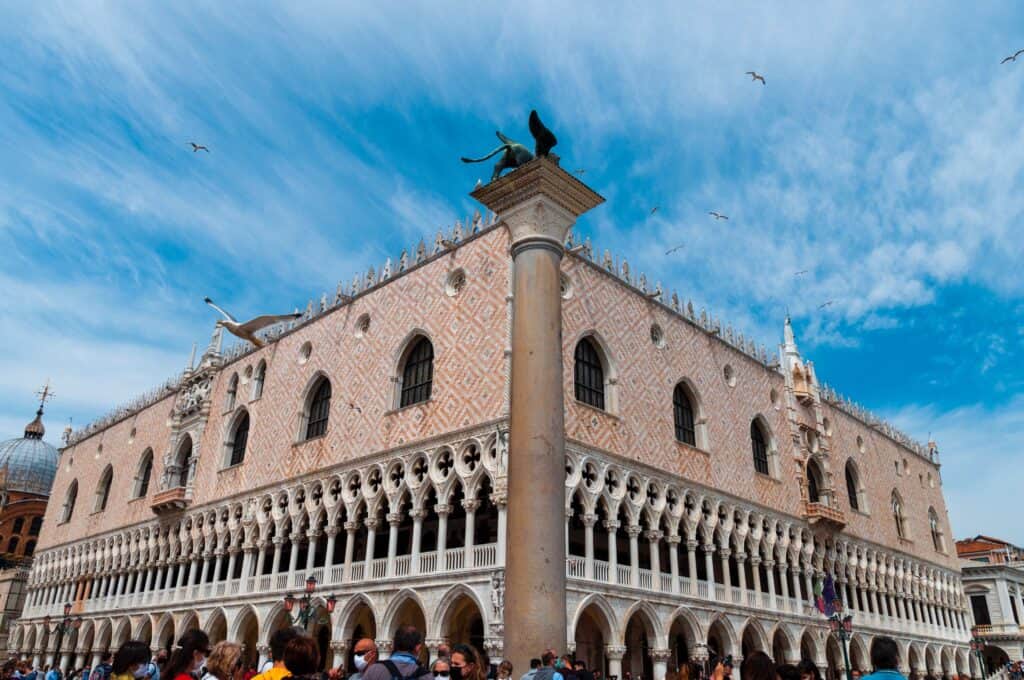
Doge’s Palace (Palazzo Ducale)
Located in the heart of Venice and next to St. Mark’s Basilica, the Doge’s Palace was the most important building during the Venetian Republic. This gothic palace was the seat of the government, justice court, prison and home of the Doge (the Head of State of the Republic of Venice).
Today the palace serves as a reminder of the power and grandeur of the Venetian Republic. Inside the Doge’s Palace, you can witness the opulent ldecorations, artworks, and sculptures that are on display.
The palace also houses incredible works of art by renowned Renaissance masters such as Tintoretto, Titian and Veronese.
From the palace you have access to the prisons and can also visit the enclosed Bridge of Sighs.
The Doges Palace is open all year round, except on Christmas and New Year’s day. There is an admission fee to enter.
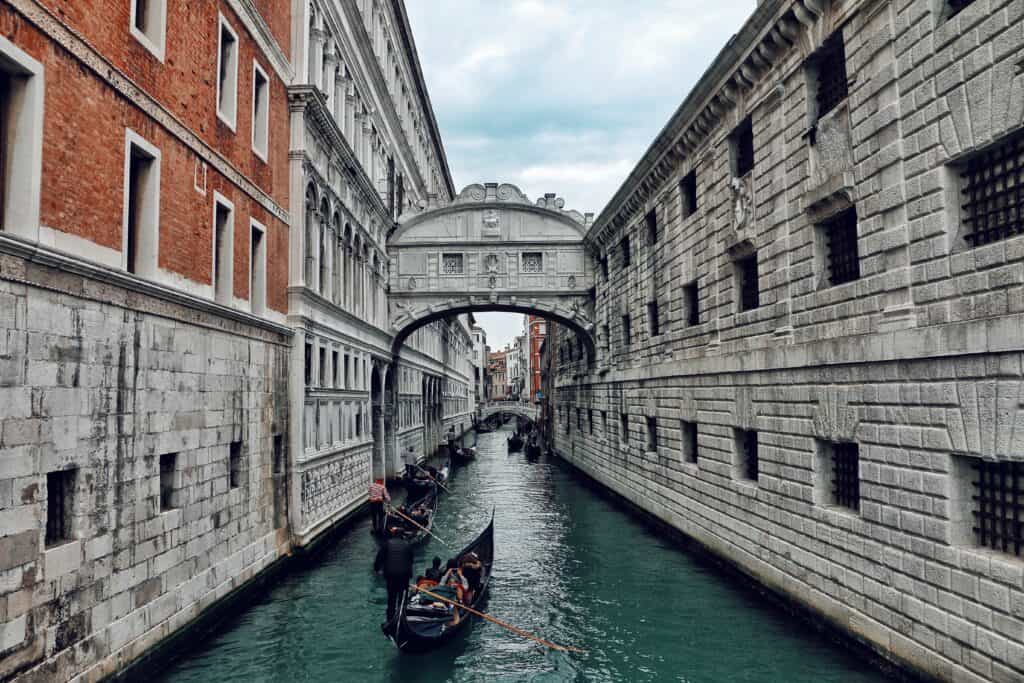
Bridge of Sighs (Ponte dei Sospiri)
Another iconic sight in Venice is the Bridge of Sighs. This enclosed bridge spans a narrow canal connecting the Doge’s Palace to the Prison, and its name comes from a legend that prisoners “sighed” as they caught their last glimpse of freedom through the window spaces on the bridge before being taken away.
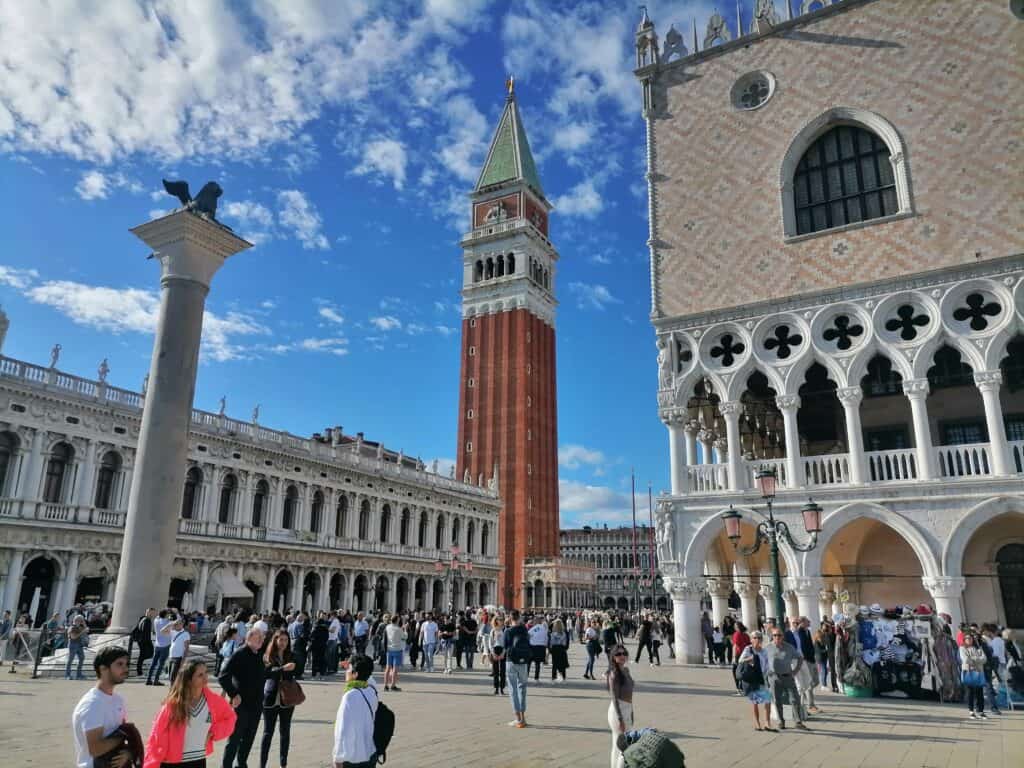
St Mark’s Campanile (Campanile di San Marco)
This free-standing bell tower is one of the tallest structures in Venice. Standing at 98.6 metres and the bells were rung to regulate civil and religious life during the Republic era.
From the observation floor at the top of the tower, the campanile offers great views of city and the lagoon and well worth a visit.
The tower is open daily from 9:30am-9:15pm, the last admission is at 8:45pm; tickets can be purchased at the tower.

St. Mark’s Clocktower (Torre dell’Orologio)
This landmark clock tower is located on St. Mark’s Square and was built in the 15th century. This architectural marvel showcases the ingenuity of Renaissance engineering. As you stand beneath its stunning facade, adorned with intricate astrological and religious symbols, you’ll be captivated by the elegant dance of the clock’s mechanical figures, which come to life at each hour.
Visits to St. Mark’s Clock Tower are only allowed as part of a small group guided tour.
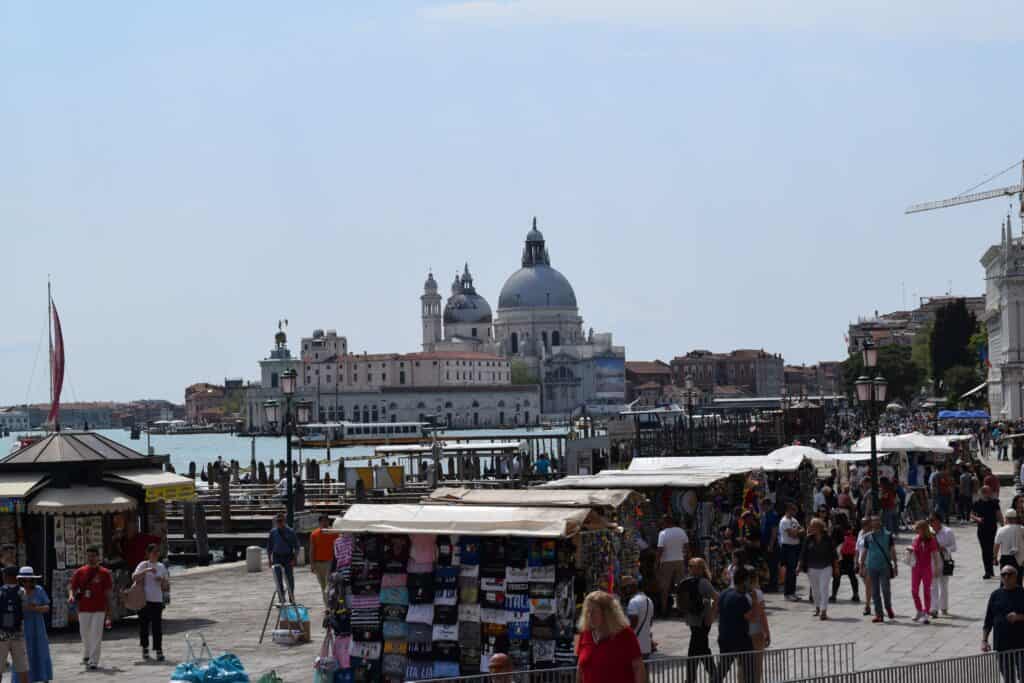
Riva degli Schiavoni
Riva degli Schiavoni, a bustling waterfront promenade in Venice around the corner from St. Mark’s Square. Lined with historic palazzos, hotels, charming cafes, and souvenir stands, this lively stretch along the lagoon is a perfect place to soak in the authentic Venetian ambiance. As you stroll down the Riva, you’ll be captivated by the sight of gondolas gracefully gliding through the water, with the magnificent backdrop of the lagoon.
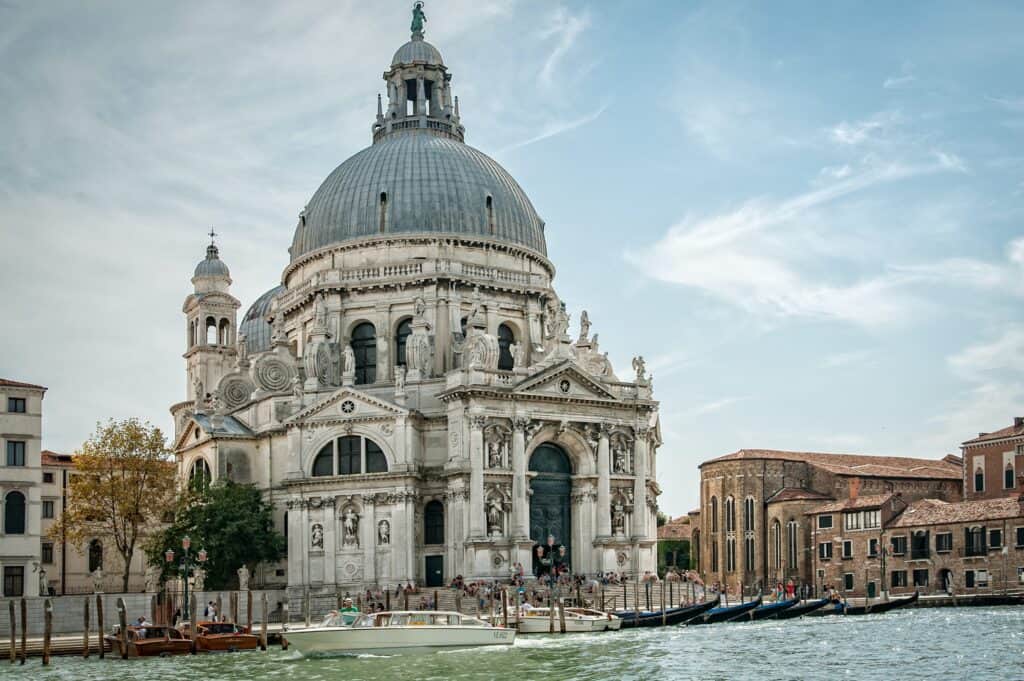
Best Churches In Venice
A visit to the churches of Venice is an essential part of any trip to this magnificent city. These sacred spaces offer you a fascinating glimpse into the city’s rich history, as well as a chance to appreciate some of the most exquisite works of art and architecture in the world.
There are over 170 churches in the city and islands of the lagoon and here are our top recommended churches to visit.
Santa Maria della Salute
One of the most iconic churches in Venice, Santa Maria della Salute is a true masterpiece of Baroque architecture. Located at the tip of the Dorsoduro district, the church was built as a votive offering for the city’s deliverance from the plague that ravaged it in the early 17th century.
Designed by Baldassare Longhena, the church boasts an impressive dome and bell towers that dominate the skyline of Venice.
Inside, you will be greeted by a lavish interior adorned with marble and gilt, and filled with priceless works of art, including paintings by Tintoretto and Titian. The high altar is particularly striking, with its opulent decoration and magnificent domed ceiling. With its stunning setting on the Grand Canal and its rich artistic legacy, Santa Maria della Salute is a must-visit destination for anyone traveling to Venice.
The church is free to visit, however there is an admission fee to visit the seminary museum and the panoramic terrace. The church is open every day: from 9:30-12pm and from 3pm-5:30pm.
Basilica di Santa Maria Gloriosa dei Frari
The Basilica di Santa Maria Gloriosa dei Frari, commonly known as simply the Frari, is a Gothic church located in the heart of the San Polo district. Completed in the 14th century and one of the biggest churches in Venice. A simpler church on the outside however inside you will see monumental art from renaissance masterpieces by Titian, Bellini and Donatello. Titian himself is buried here.
The church is open 9am-6pm Monday to Saturday and 1pm-6pm on Sunday. There is an entrance fee.
Chiesa di Santa Maria Assunta (Church of Gusuiti)
Built by the religious order of the Jesuits, this prominent 18th-century Baroque church features an elegant façade and a lavish interior design filled with frescoes and statuary.
The Chiesa di Santa Maria Assunta, also known as the Church of the Assumption, is a small but stunning church located in the Cannaregio district of Venice.
Built in the 18th century, this baroque church features an elegant facade and a rich interior, which boasts an impressive collection of artwork. Despite its relatively small size, the Chiesa di Santa Maria Assunta is a true gem of Venetian architecture and a must-see destination for anyone interested in the city’s rich artistic heritage.The masterpiece of this building is its main altar along with one of Titian’s last paintings (The Martyrdom of St. Lawrence).
The church is open everyday from 10am-12pm and 4pm-6pm and free admission.
Chiesa di Santa Maria dei Miracoli
The Church of Miracles is an extraordinary Renaissance gem located in the Cannaregio district. Built between 1481-1489 to house a revered painting of the Virgin Mary and believed to be capable of performing miracles. Lavishly embellished with precious marble and stones, this church has become a premier destination for wedding ceremonies; every bride desires to exchange their vows within its walls due to alluring photo opportunities. However, as demand far surpasses availability you must make reservations at least two years ahead.
The church is open 10:30am-4:30pm Monday to Saturday. There is an entrance fee.
Santi Giovanni e Paolo (San Zanipolo)
The Basilica Santi Giovanni e Paolo, otherwise known as the Venetian Pantheon is located in the Castello This brick 14th century gothic-style is adorned with stunning works of art, including paintings by Bellini, Veronese, and Titian. The church is also home to numerous tombs of important Venetian figures, including 25 doges, which are located in the monumental funerary complex.
The church is open 9am-6pm Monday to Saturday and Sunday from 12pm-6pm. There is an entrance fee.
Madonna dell’Orto
Madonna dell’Orto is a beautiful church located in the Cannaregio district. Built in the 14th century, the church is one of the city’s most striking examples of gothic architecture. The facade of the church features a stunning rose window and intricate carvings, while the interior is adorned with magnificent frescoes and paintings. This captivating church houses paintings from one of history’s greatest painters, Tintoretto, who lived nearby and favoured this church. Today his tomb is situated inside the building close to the main altar.
The church is open 10am-5pm Monday to Saturday. There is an entrance fee.
San Pantalon
San Pantalon is a beautiful church located in the Dorsoduro district. Built in the 17th century, the church is known for its impressive ceiling fresco depicting the Martyrdom and Apotheosis of Saint Pantaleon. The fresco is one of the largest in Venice, covering over 400 square meters, and is considered one of the best examples of Baroque art in the city.
San Pantalon is a must-see for art lovers visiting Venice, and its one-of-a-kind fresco and impressive architecture make it a standout among the city’s many churches.
The church is open Monday to Saturday 4-6pm and Sunday 5-6pm and free entrance.
San Sebastiano
Built in the late 1500s and located in the Dorsodura district, this church is known for its stunning interior artwork by Paolo Veronese. The paintings depict scenes from the life of Saint Sebastian, the church’s namesake, and are considered some of the artist’s most impressive works.
The church’s interior also includes intricate wood carvings, marble statues, and a beautiful altar. Outside, the church’s facade features a simple yet elegant design with a large rose window.
San Sebastiano is a must-see for Veronese art enthusiasts visiting Venice who was entombed here.
The church is open 10:30am-4:30pm Monday to Saturday. There is an entrance fee.
Santa Maria del Giglio
Translated into St. Mary of the Lily, this church was initially constructed during the 10th century and then reconstructed in the 17th. Located in the San Marco district this church has an impressive Baroque facade with intricate carvings and sculptures.
Inside one can find stunning artwork and sculpture including the only piece of art in Venice by painter Peter Paul Rubens.
The church is open 10:30am-4:30pm Monday to Saturday. There is an entrance fee.
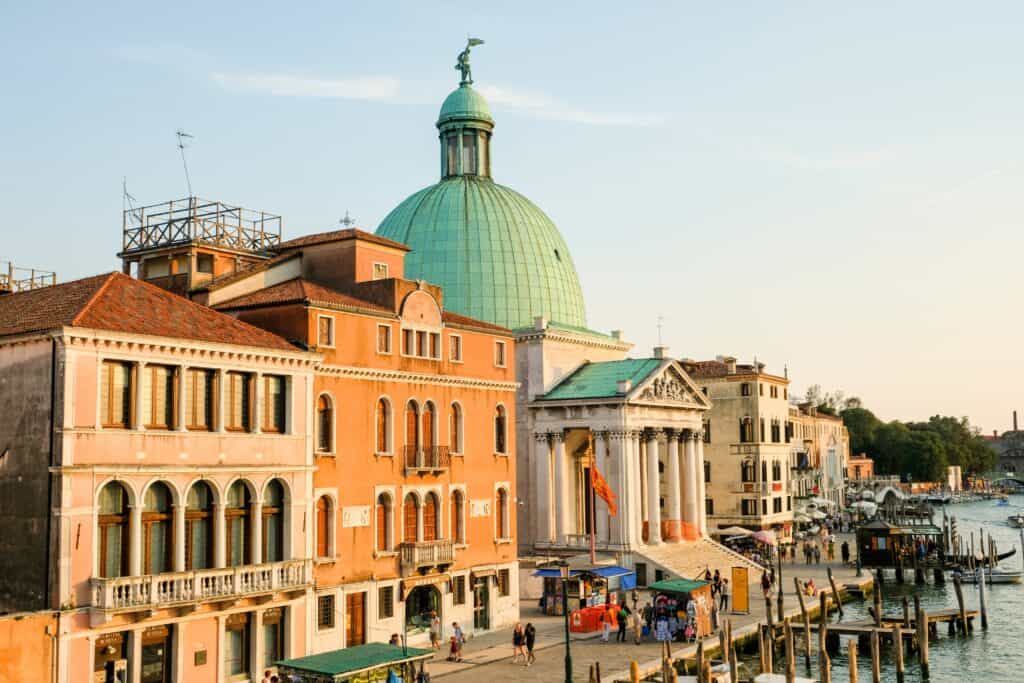
San Simeone Piccolo
The iconic green dome of Chiesa di San Simeone Piccolo is the first thing that captivates visitors when they arrive in Venice via bus or train.
Built in the 18th century, this baroque-style church showcases an impressive dome and a stunning facade that boasts intricate details and beautiful sculptures. The interior of the church is adorned with magnificent frescoes and stunning artwork.
With its unique location on the Grand Canal, San Simeone Piccolo offers stunning views of the water and the surrounding architecture of Venice.
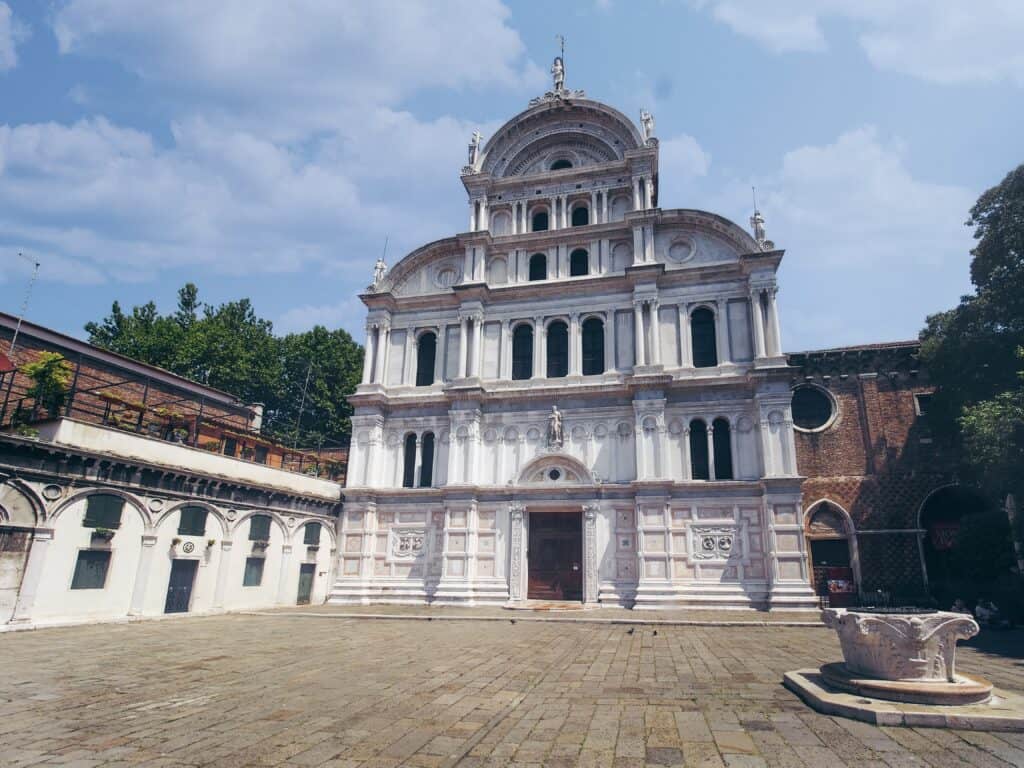
Chiesa di San Zaccaria
This early Renaissance church located in the Cannaregio district boasts an impressive interior decorated in marble. The crypt area is also worth exploring as it is always flooded so the water gives off a beautiful reflection.
The church is open daily 10am-12pm and 4pm-6pm. There is an entrance fee.
Admission Fees
In Venice, many churches charge entrance fees to help cover the cost of maintenance, restoration, and the preservation of these historic buildings. The upkeep of Venetian churches is essential to their continued existence and enjoyment by future generations. The churches are also home to numerous works of art, from paintings by famous artists to intricate sculptures and mosaics, which are often displayed in ornate chapels or grandiose altars. Funding from entrance fees helps to support the ongoing conservation of these priceless treasures.
The Chorus Pass is a ticket that gives you access to many of the city’s most beautiful churches, By opting for the Chorus Pass, you can save time and money while taking in some of the most breathtaking architectural and artistic treasures in Venice.
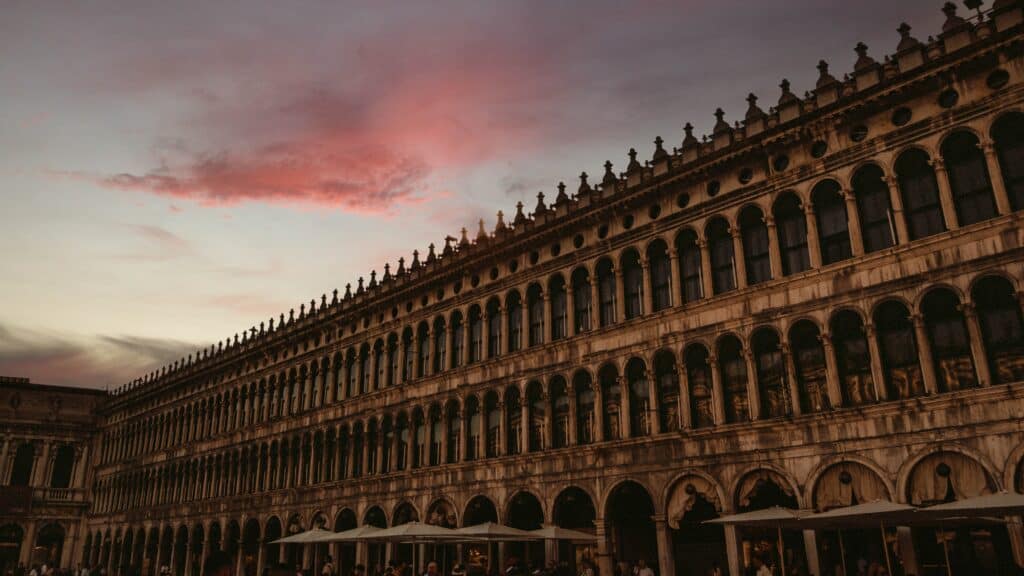
Best Museums
Venice is home to some of the most fascinating and historically significant museums in the world. From the Gallerie dell’Accademia to the Peggy Guggenheim Collection, there is something for everyone to enjoy. These museums offer a unique opportunity to explore the rich cultural heritage of Venice, with exhibits showcasing everything from Renaissance art to contemporary works by modern artists. In addition to their impressive collections, many of these museums are housed in stunning architectural landmarks, such as the Palazzo Grassi and the Ca’ d’Oro. Whether you’re a history buff, an art enthusiast, or simply looking to broaden your cultural horizons, a visit to the museums in Venice is an absolute must.
Here are some of the best museums to visit.
Gallerie dell’Academia
Gallerie dell’Accademia is a world-renowned museum located in the Dorsoduro district and houses an impressive collection of artwork from some of the most famous Renaissance artists in history, including Leonardo da Vinci, Michelangelo, and Raphael. The museum’s collection spans the 13th-17th centuries and showcases masterpieces such as the “Vitruvian Man” and “David and Goliath.”
The museum is also housed within a beautiful building that dates back to the 18th century, adding to the overall experience of visiting this cultural landmark. With its unparalleled collection of Renaissance art and its stunning location in Venice, the Gallerie dell’Accademia is a must-visit destination for anyone interested in art and history.
Peggy Guggenheim Collection
The Peggy Guggenheim Collection is a modern art museum located in the Dorsoduro district. The museum is housed in the Palazzo Venier dei Leoni, an 18th-century palace that was once home to Peggy Guggenheim, a wealthy American heiress and art collector.
The collection features a unique selection of modern art, with works by artists such as Jackson Pollock, Salvador Dali, and Pablo Picasso, among others. Here you can explore the various galleries and exhibits, which showcase everything from surrealist paintings to abstract sculptures. Aside from its impressive collection of art, the museum’s location on the Grand Canal offers stunning views of the water and surrounding architecture. With its unparalleled collection of modern art and its beautiful location, the Peggy Guggenheim Collection is a must-visit destination for modern art lovers.
Ca’ Pesaro International Gallery of Modern Art
The Ca’ Pesaro International Gallery of Modern Art is a prestigious museum located in the Santa Croce district. Housed in a beautiful Baroque palace that dates back to the 17th century, the museum features an impressive collection of modern and contemporary art.
Here you can explore and the galleries filled with works by Klimt, Kandinsky, and Munch, among others. The museum’s extensive collection spans several periods, including Futurism, Surrealism, and Pop Art. In addition to its permanent collection, the museum also hosts temporary exhibitions and events throughout the year. With its stunning collection of modern and contemporary art and its beautiful location on the Grand Canal, the Ca’ Pesaro International Gallery of Modern Art is a must-visit destination for any art lover.
Ca’Rezzonico
Ca’Rezzonico is a magnificent 18th century palace located in the Dorsoduro district. It which was commissioned by one of the city’s noble families who used the best architects to build a dream home. Every room showcases artwork, sculptures, furniture and frescoed ceilings. The second floor proudly displays works by Venetian painters Pietro Longhi and Giandomenico Tiepolo while the third level houses a replica of an 18th-century pharmacy.
Scuola Grande di San Rocco
Scuola Grande di San Rocco is a stunning Renaissance-era building located in the San Polo district. Built in the 15th century and is renowned for its beautiful architecture, intricate interior decorations, and impressive collection of artwork. The Scuola Grande di San Rocco is best known for its series of paintings by the famous Venetian artist Tintoretto, which adorn the walls and ceilings of the building’s numerous galleries. Here not only can you marvel at the beauty and grandeur of this building but also admire the many works of Tintoretto.
Palazzo Grassi & Punta della Dogana
Palazzo Grassi and Punta della Dogana are two prestigious contemporary art museums that showcase the Pinault collection of modern art.
The Palazzo Grassi is housed in an elegant 18th-century palace that has been beautifully restored to showcase contemporary art exhibits. The museum features an impressive collection of artwork by both established and emerging artists from around the world.
Meanwhile, the nearby Punta della Dogana is a former customs building that has been transformed into another contemporary art museum.
Both museums form one of the largest collections of contemporary art in the world. In the galleries who can advise works by Damien Hirst, Jeff Koons, and Takashi Murakami, among others. In addition to their impressive collections, both museums offer stunning views of the Grand Canal and surrounding architecture, making them a must-visit destination for anyone interested in modern art.
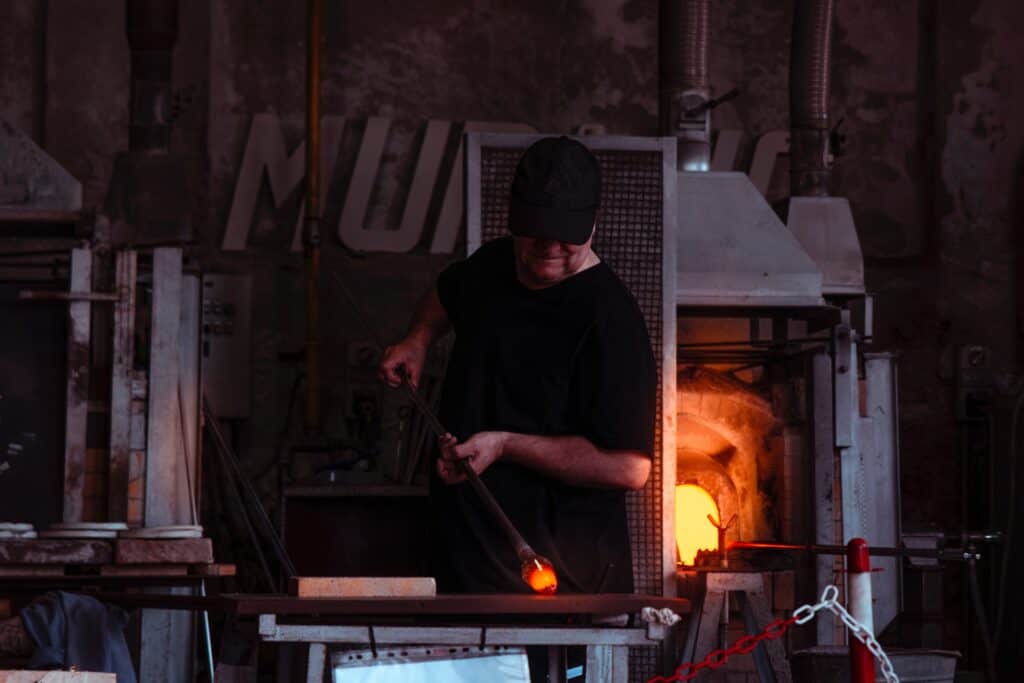
Murano Glass Museum
The Murano Glass Museum showcases the rich history and artistry of Murano glass, which has been renowned for centuries for its incredible beauty and craftsmanship. At this museum you can admire the many exhibits of glassware from different periods and styles and learn about the history of glass-making which dates back over 700 years.
Museo del Merletto (Lace Museum)
The colourful Venetian island of Burano gained notoriety for its lace-making. Considered luxury wear in the 17th century, wealthy Europeans incorporated it into their clothing so Burano lace became a hot commodity and Burano lace makers produced some of the best lace of all.
Located in the historic Palazzo del Podesta, which was built to house the rulers of Burano and then became the school of lacemaking 1872. The museum showcases an impressive collection of lacework from the 16th to the 20th century. Here you can explore the galleries and marvel at the exquisite craftsmanship of the lace pieces on display, which range from delicate handkerchiefs to intricate lace dresses and accessories.
The Museo del Merletto is a must-visit destination for anyone who appreciates the delicate beauty of lace-making, the artistry and the dedication required to create these beautiful and intricate pieces.
Museo Storico Navale (Museum of Naval History)
The Museo Storico Navale is a fascinating museum dedicated to the history of naval technology and maritime exploration. Here you can explore the galleries and view exhibits that showcase the history of the city’s naval and maritime history. The museum also features an impressive collection of naval artifacts, including models of ancient ships, weapons, and paintings depicting naval battles and explorations. One of the highlights of the museum is the opportunity to view the actual ships used by the Venetian Navy throughout history including a richly decorated 45-metre shop that transported the doge.
The Museo Storico Navale is a must-visit destination for anyone interested in naval history or maritime exploration.
Correr Civic Museum
The Correr Civic Museum offers a comprehensive overview of the city’s past, from its inception to the 19th century and its union with Italy. Located on St. Mark’s Square the museum includes an art gallery and a huge collection of artefacts from the Venetian Republic.
You can also view the opulent Napoleonic Wing with its neo-classical architecture where the Emperor set up his reign in the 1800s. You can tour the sumptuously decorated imperial rooms including the ballroom, throne room and banqueting hall.
The museum offers stunning view of St. Mark’s Square.
An entrance ticket also covers entry into the National Archaeological Museum and the Marciana National Library; which is part of the same building complex.
The National Archaeological Museum consists of a huge collection of ancient sculptures, ceramics, jewels and coins.
The National Archaeological Museum is dedicated to showcasing the rich history and culture of ancient Italy, and features an impressive collection of sculpture, ceramics, coins, jewels and other archaeological artefacts from different periods of Italian history. One of the highlights of the museum is the collection of ancient Roman coins, which offer a unique glimpse into the economic and political history of the ancient world.
The Marciana Library is a magnificent institution that is a must-visit for book lovers and history buffs offers you a chance to explore one of the most important collections of ancient texts and manuscripts in the world.
The interior of the library is beautifully decorated by Renaissance masters such as Tintoretto and Titian, making it a truly breathtaking sight to behold.
Here you can browse the stacks and view a wide range of rare books, maps, and manuscripts, including works by famous authors such as Dante and Petrarch. Whether you are a scholar or simply someone who appreciates the beauty and history of books, a visit to the Marciana Library is a must visit.
Grimani Palace
The Grimani Palace is an iconic landmark in Venice, renowned for its stunning architecture and impressive collection of art and artifacts. Originally built in the 16th century, the palace was once home to once home to Antomio Grimini, a very successful merchant who became a Doge in 1521.
Today, the palace houses a museum that showcases an impressive collection of art and artefacts from different periods in Venetian history. Here you can explore the galleries and admire paintings, sculptures, and other historical artefacts, including a large collection of Greek and Roman antiquities.
With its rich history, exquisite architecture, and impressive collection of art and artifacts, the Grimani Palace is a must-visit destination for anyone interested in the beauty and culture of Venice.
Museum & Church Passes
If you happen to be in Italy on the first Sunday of the month, many museums are free to enter. This is because of a 2014 legislation that the Italian Minister of Culture granted to encourage people to learn more about Italy’s history.
If you are planning on spending several days exploring the city’s museums and galleries, purchasing a museum pass can be a great way to save money and gain access to multiple venues at a discounted rate.
One popular option is the Venice Museum Pass, which provides entry to 11 different museums and cultural sites throughout the city.
Another option is the Palazzo Ducale Secret Itineraries tour, which takes you behind the scenes of one of Venice’s most iconic landmarks.
Other passes include the Chorus Pass, which provides entry to over 20 churches in Venice, and the Museum Pass San Marco, which includes access to the buildings within the St. Mark’s Basilica complex.

Opera & Classical Music
Venice is a city that is synonymous with classical music and opera, and for good reason. From the grandeur of La Fenice to the intimacy of small churches and chapels, there are endless opportunities to experience world-class performances in some of the most stunning and historic venues in the world.
One of the most iconic venues in Venice is without a doubt La Fenice Opera House. Rebuilt after a devastating fire in 1996, La Fenice is renowned for its sumptuous décor, impeccable acoustics, and illustrious history. La Fenice offers a range of performances, from traditional operas by composers such as Verdi and Rossini to contemporary works by modern composers.
Two options are available for visiting this theatre, the first is attending an opera performance and the second is a guided tour.
But La Fenice is not the only venue for classical music and opera in Venice. The Scuola Grande di San Teodoro is another stunning venue that hosts regular concerts and performances. Located close to St. Mark’s Square, this historic building offers an intimate and atmospheric setting for chamber music and other classical performances.
If you are looking to experience classical music in a more informal setting, Venice has plenty of options as well. Many small churches and chapels throughout the city offer regular concerts featuring everything from Bach to Vivaldi to contemporary composers. These performances often take place in the early evening and are a perfect way to wind down after a day of sightseeing.
No matter what kind of classical music or opera you’re interested in, Venice has something to offer. With so many incredible venues and performances to choose from, it’s easy to see why this city has been inspiring musicians and composers for centuries. So why not add a night at the opera or a classical concert to your Venice itinerary? It’s an experience you won’t soon forget.
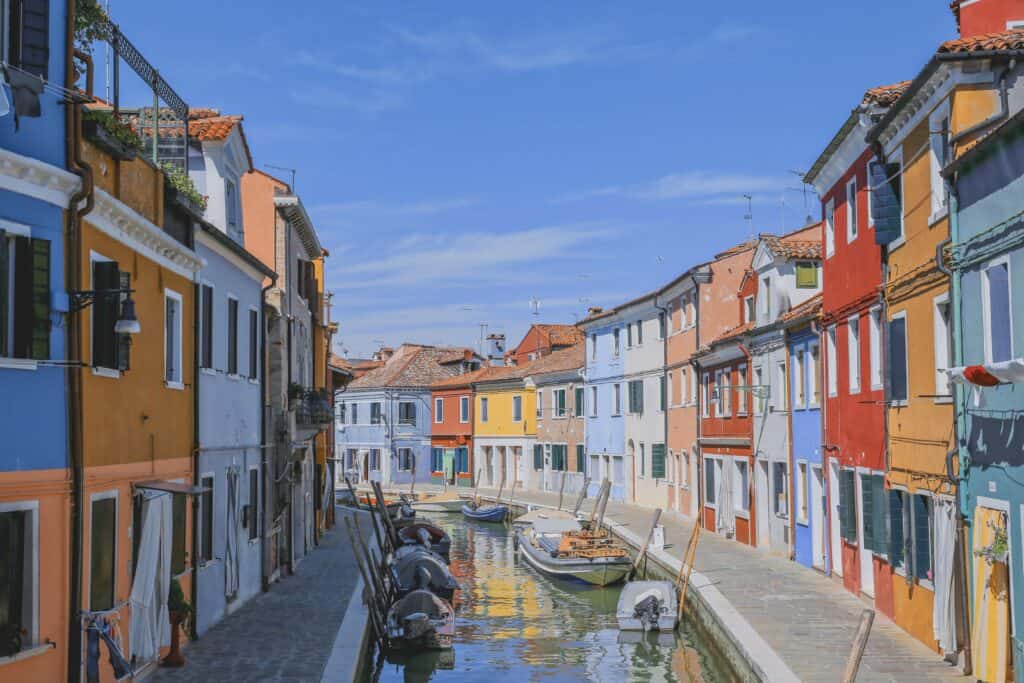
The Venice Lagoon
There are 118 islands in the Venice Lagoon, so if you have time, spend a day exploring some of these islands. Here are the top ones to visit.
Murano
Murano is a small island located just a short boat ride away from Venice, and is renowned for its exquisite glasswork and charming canals. The island has been a hub of glassmaking since the 13th century and is home to some of the most skilled artisans in the world.
Visiting Murano you can explore the island’s glass factories and workshops, where they can watch master glassblowers at work and purchase one-of-a-kind glass pieces to take home as souvenirs.
In addition to its glassmaking heritage, Murano is also home to a number of historic churches and museums, including the Murano Glass Museum, which showcases the history of glassmaking on the island.
The vaporetto system runs between Venice and Murano regular all year round.
Burano
Burano is a charming island located in the Venetian lagoon, famous for its brightly coloured houses and intricate lacework.
The island is also home to a number of artisan workshops, where you can watch skilled lace makers at work and purchase unique handmade souvenirs. In addition to its colourful architecture and traditional crafts, Burano is also home to a number of historic churches and museums, including the Museum of Lace and the Church of San Martino.
Burano is about 7 km from Venice and can be easily visited using the Vaporetto system that runs regularly every day.
The Lido
The Lido is a narrow island located just off the coast of Venice, and renowned for its picturesque beaches and relaxed atmosphere, making it the perfect escape from the hustle and bustle of the city.
Visiting the Lido, you can relax at the beach or explore the island’s many shops and restaurants. The Lido is also home to the famous Venice Film Festival, which takes place every September and attracts filmmakers and cinephiles from around the world.
Torcello
Torcello is a small island located in the northern end of the Venetian lagoon, and is one of the most ancient settlements in the region.
The island is small and much of it is a natural reserve accessible by paths.
One of the main attractions on the island is the Basilica of Santa Maria Assunta, which houses stunning Byzantine mosaics that date back to the 11th century. In addition to the basilica, Torcello is home to a number of other historic landmarks, including the Devil’s Bridge, which dates back to the 15th century.
Torcello can be easily reached by Vaporetto. The service operates daily using the same Vaporetto line as Burano; which is only 5 minutes away.
San Michele
Across the waters from the Cannaregio district is the Island of San Michele. This red-walled island is Venice’s cemetery since the 1800’s and is solely occupied by tombs and chapels.
If visiting, photography is not allowed within the walls and remember to follow the usual rules of decorum when visiting a cemetery.
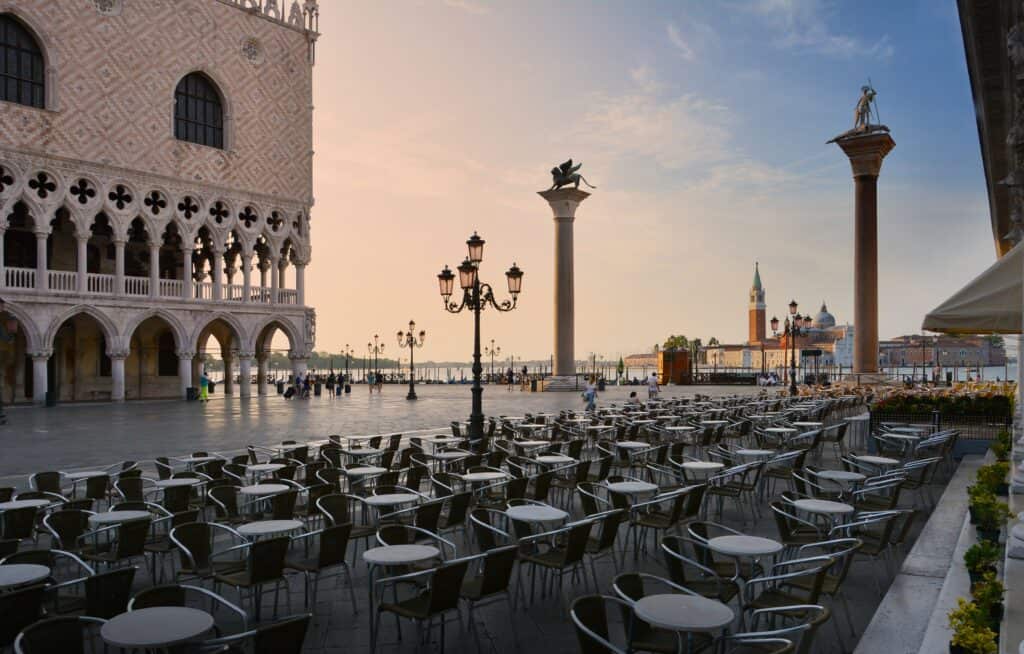
Best Historic Cafes
Venice is where the European coffee shop culture was born and the city still has some of the continent’s oldest and most famous coffee venues. For centuries, these establishments have been gathering places for intellectuals, artists, and locals offering a unique glimpse into the social and cultural fabric of Venice.
Here are just a few of the most iconic and historic cafes in the city:
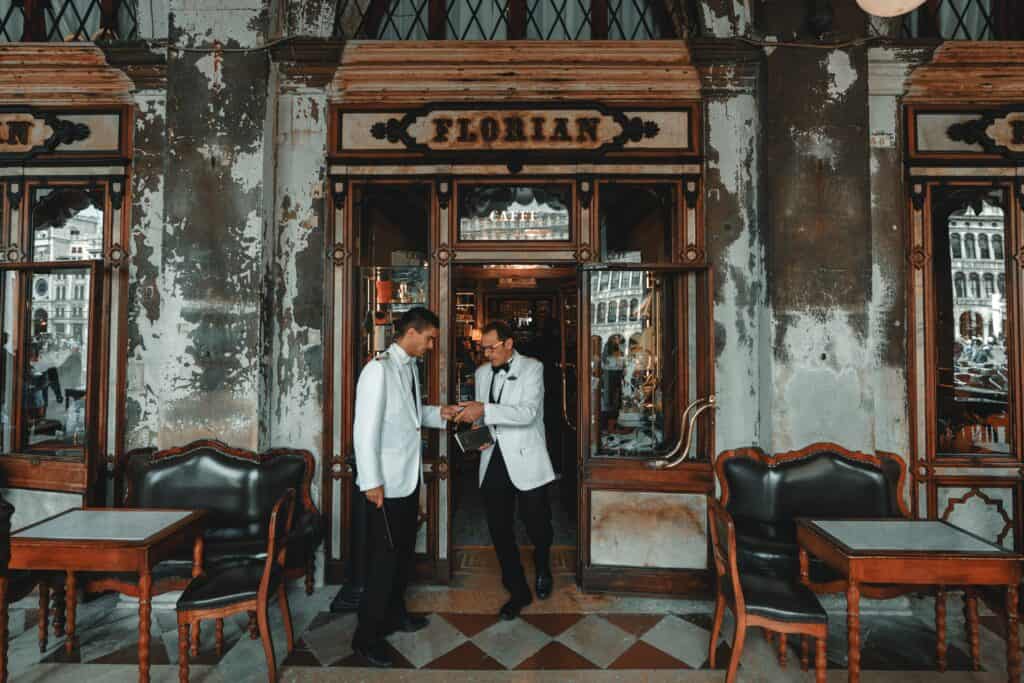
Caffè Florian: Founded in 1720, Caffè Florian is one of the oldest and most famous cafes in Venice. Located in the heart of St. Mark’s Square, the cafe has played host to countless luminaries throughout its history, including Lord Byron, Charles Dickens, and Marcel Proust. Coming to Caffè Florian can enjoy a wide range of coffee and pastries while admiring the opulent decor and stunning views of the square. An expensive place for sure, but also the most glamorous spot in town.
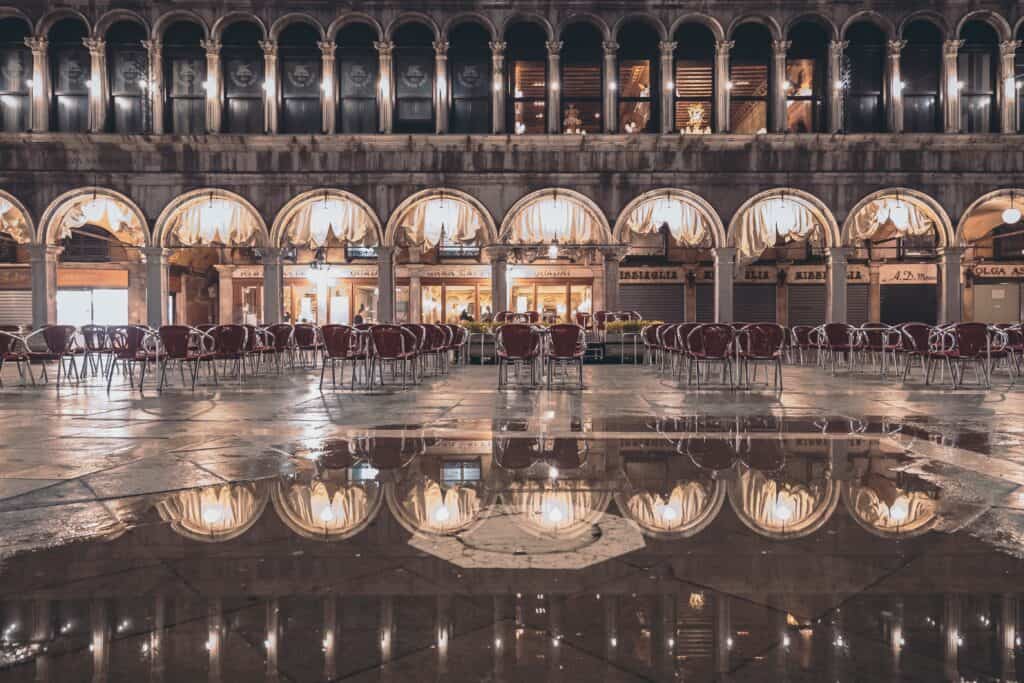
Caffè Quadri: Established in 1775, Caffè Quadri is another iconic cafe located in St. Mark’s Square. The cafe is known for its elegant interior and exquisite pastries, as well as its impressive selection of wines and spirits. Outside you can enjoy wonderful views of the Square while listening to a classical orchestra.
Caffè Rosso: Located near the Rialto Bridge, Caffè Rosso is a historic establishment that has been serving locals for years. The cafe is known for its relaxed atmosphere and charming decor, as well as its delicious coffees and pastries.
Caffè Lavena: Founded in 1750, Caffè Lavena is another iconic establishment located in St. Mark’s Square. Again, a more pricier place due to it’s location, but another great place if you are after grand historical ambience.
Harry’s Bar: Not a coffee shop, but must be mentioned. This iconic 1930s bar is renowned for its historic patrons (Lord Byron, Marcel Proust, Orson Welles) as it is for its signature Bellini cocktail and Beef Carpaccio – both of which were invented here. Bellini is a drink made with white peach juice and prosecco named after the 15th century painter Giovanni Bellia. Beef carpaccio is thinly sliced sirloin served with a lemon juice and mayonnaise dressing. Named after the Italian painter Vittore Carpaccio who was famous for using deep reds in his paintings. Also declared a national landmark in 2001, this bar continues to attract tourists from around the world and for many a must-visit. (To note, for better views sit upstairs).
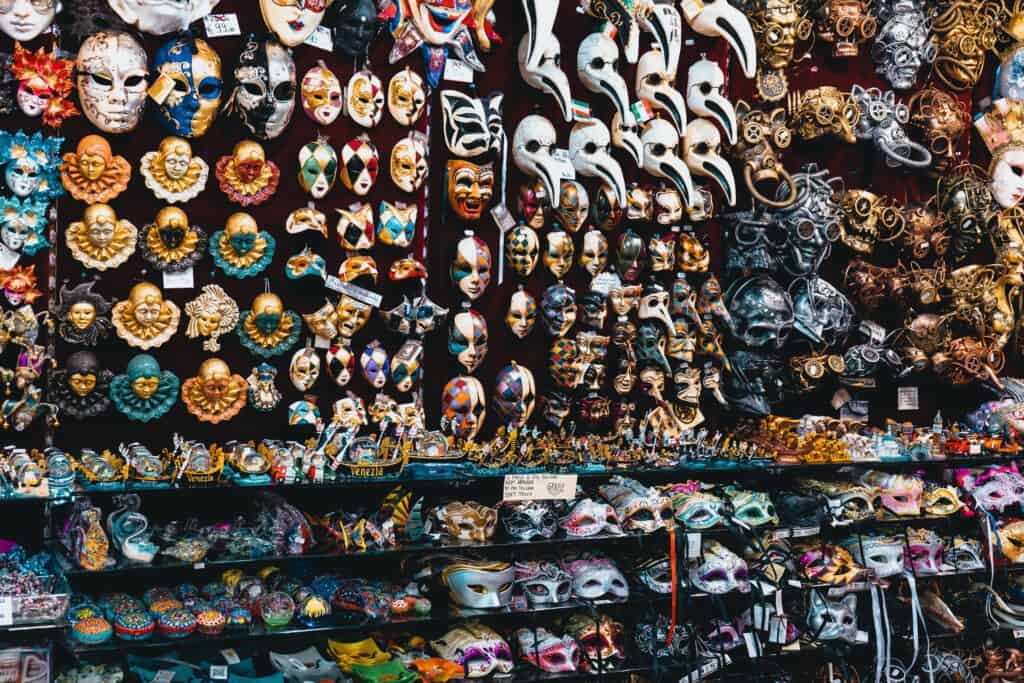
Shopping
Venice is home to an abundance of shops and markets, perfect for finding special souvenirs to take back home with you.
Here are the most popular spots in Venice when it comes to shopping.
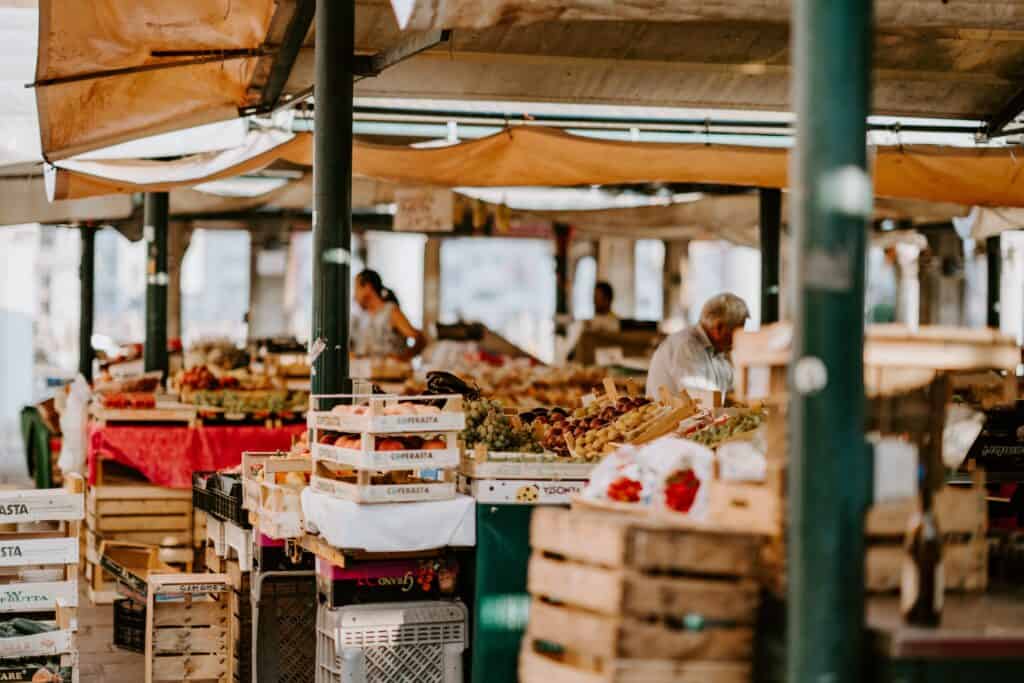
The Rialto Market: The Rialto Market is one of the oldest and most popular markets in Venice, stretching along the Grand Canal and held daily for almost 1,000 years. Here, you will find seasonal produce and local specialist food. A fish market is also linked to this complex and is located under the lodges. If you plan to visit this market, go early to see local daily life in action. (Opening hours Rialto Market – Mon-Sat -7am-8pm. Fish Market – Tue – Sat – 7am-2pm).
Le Mercerie & Calle dei Fabbri: This is the main shopping area in Venice, near the Rialto Bridge and St. Marks Square. Here you will find many international and independent shops and stands offering clothing, gifts, artwork and jewellery.
Calle dei Nomboli & Cannaregio District: If you are looking for more traditional Venetian souvenirs or the more artisan shops head to Calle dei Noboli and the Canneregio district.
Fondaco Dei Tedeschi: This is a luxury shopping centre/mall over four floors of a Renaissance building not far from the Rialto Bridge. Filled with Italian and International shops. For great 360-degree views of the city, go to the stunning roof terrace.
Libreria Acqua Alta: If you are a book lover then visit the Libreria Acqua Alta. The shop translates to “high water bookshop”. To make sure that the books do not get damaged with the flooding, there will be piled in gondolas, bathtubs and canoes.
I Tre Mercanti: This gourmet food shop offers a great selection of produce and wine that is always changing with the season. A great place for foodies.
Finally, no trip to Venice would be complete without a visit to the city’s many gelaterias, where you can indulge in creamy, delicious gelato in a rainbow of flavours. For further information about eating Gelato in Italy, read our Gelato Guide which covers the best gelaterias in Italy including Venice.

So To Wrap Up On Things To Do In Venice
The city of Venice is truly breathtaking, an undeniable treasure that draws people from all over the world. From the canals to historic attractions, incredible architecture and picturesque vistas in every direction, there is so much to explore here. We hope this ultimate guide shows you all the best things to do in Venice.
For another great Italian city recommendation, read our blog post on The Best Things To Do in Bologna – Italy’s University City.
Further FAQs
Do You Have To Pay To Enter Venice?
Those that are visiting Venice for the day must pre-pay an entry fee. If you are staying overnight then you will be exempted as you are already paying tax on your accommodation.
Is There A City Pass For Museums & Attractions?
Venice has several city passes and tourist cards that cover admission to the main tourist sites, museums and public transport.
If you are planning on visiting museums and major sites, make sure you check out the options available to fast-track queues and get the best value.
Which Airports Serve Venice ?
The two main airports are Marco Polo Airport and Treviso Airport. Both provide easy access to the city via public transportation or taxis.
Marco Polo Airport is located on the mainland of Venice (12km) away from the centre while Treviso is located about 25km away.
When Is The Best Time To Visit Venice?
The best time to visit is during the mild months of spring or fall/autumn. From April until June and September until early October, temperatures are warm but not too hot, with cool evenings. The tourist services will be fully operational but the crowds will be less.
Try and avoid July and August as this is generally peak season and the weather will also be hot and humid.
Winter, of course is going to be much quieter but it will be colder/rainy and there is more chance of flooding.
What Are The Public Transport Options?
Venice is a city unlike any other, with its network of canals and narrow streets that make traditional land-based transportation impossible. So here are the transport options available when getting around this city.
Water Taxis: Water taxis are a quick and convenient way to get around Venice’s waterways. They’re also perfect for those who want to arrive in style at their destination. Water taxis can be found at designated stands throughout the city, or you can call one ahead of time to arrange for pickup.
Vaporetto: The vaporetto is Venice’s version of a public bus and is an affordable way to see the city from the water. The boats run on a set schedule along designated routes and are marked with different numbers and colors. You can purchase tickets at ticket booths or online ahead of time.
Gondolas: Gondolas are one of the most iconic symbols of Venice and offer a romantic and luxurious way to see the city. Gondolas can be hired for private tours, and the ride typically lasts around 30 minutes. Prices vary depending on the time of day and season, so it’s best to shop around for the best deals.
Biking – Bicycles are not recommended for getting around Venice due to the city’s narrow streets and lack of bike lanes. However, if you’re looking to explore the surrounding areas outside of the city centre, renting a bike can be a fun and eco-friendly option.
Is Venice Safe To Visit?
Venice is generally considered a safe destination for tourists. Violent crime is rare, and the city’s police force is well-equipped to handle any emergencies that may arise.
However, as with any major tourist destination, visitors should be aware of pickpocketing and other petty crimes, especially in crowded areas like the Rialto Bridge or Piazza San Marco.
To avoid these issues, it’s best to keep valuables out of sight, carry a secure bag or backpack, and be aware of your surroundings.
Additionally, some areas of Venice can be more isolated at night, so it’s important to stick to well-lit and populated areas if you’re out after dark.
Overall, by taking basic safety precautions, tourists can enjoy all that Venice has to offer without fear or worry.
For more great tips on how to travel safe, read our 35 Most Important Travel Safety Tips You Should Know.
https://inspiredtravelhacks.com/35-travel-safety-tips/
How Many Days Do You Need In Venice?
Most visitors to Venice only spend a few days in the city before moving on to other places. In general, 2-4 days is considered enough time to visit the key sites and see the best of the city.
Regardless of how many days you spend in Venice, our top tip is to be prepared for how you will be spending your days and make any reservations/bookings in advance or as soon as you arrive to optimise your time.
Where To Stay?
Venice is a city of islands, canals, and narrow streets that can be overwhelming for first-time visitors. Choosing the right district to stay in can make all the difference in your holiday experience. Here are some of the best districts to stay.
San Marco: This is the bustling heart of Venice, home to iconic landmarks like the Piazza San Marco, the Doge’s Palace, and the Basilica di San Marco. Staying in this district will put you within walking distance of many of the city’s top attractions, as well as high-end shopping and dining options.
Cannaregio: Cannaregio is a quieter, residential district that offers a more authentic Venetian experience. Here you’ll find charming alleyways, picturesque canals, and local shops and restaurants.
Dorsoduro: Dorsoduro is a trendy, up-and-coming neighbourhood that’s popular with artists and young professionals. It’s home to the Peggy Guggenheim Collection, one of the city’s premier art museums, as well as the Gallerie dell’Accademia, which houses a collection of Renaissance masterpieces. The district is also known for its lively nightlife and hip bars and restaurants.
Santa Croce: Santa Croce is a convenient and affordable district located near the train station, the city’s main transportation hub. While the area may not have as many tourist attractions as other districts, it’s a great place to stay if you’re looking for budget-friendly accommodations and easy access to other parts of the city.
Lido di Venezia: For those looking to be close to the beach, the Lido di Venezia is the perfect choice. Just a short water taxi ride from the city centre, Lido di Venezia boasts sandy beaches, as well as chic cafes, restaurants, and shops.
For some great Hotel Hacks, read our Best Hotel Hacks blog post.

